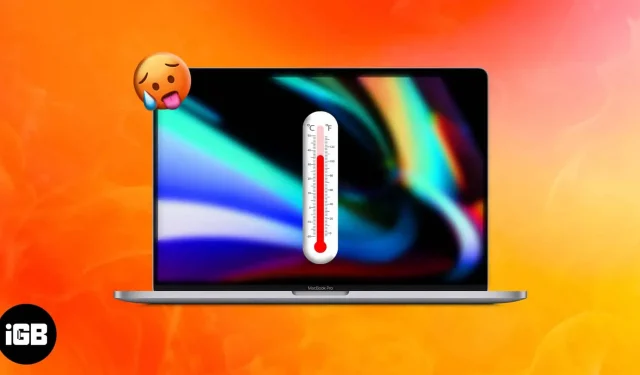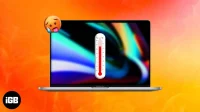Over time, as MacBooks get older, they start to have problems. Among them, the most infamous problem is overheating. A Mac on your lap becomes unbearable when it gets hot. So what do you do when your MacBook is overheating?
In this article, I will provide several solutions to prevent your MacBook from overheating. And if it overheats, you have nothing to worry about; you can take a look at some hardware and software solutions to solve your problems.
- What Causes a MacBook to Overheat?
- How to stop a Mac from overheating
- Solutions for hardware problems with overheating in MacBook
- Solutions to software problems with MacBook overheating
What Causes a MacBook to Overheat?
Serval factors can cause your MacBook to overheat. One of the main reasons is the blockage of the fan of your MacBook Pro. Another reason could be using a faulty charger. Or you might make some stupid mistakes and damage your MacBook.
Let’s say you feel like your device is physically in top condition but still overheating. In this case, software problems such as a large amount of software, unnecessary background processes, irregular shutdowns, etc. may be problems. The list is endless. Read on to find out more as I will be discussing these issues one by one.
How to prevent your Mac from overheating?
Now that we know that MacBook overheating problems can be divided into two parts, let’s look at the solutions.
Pro Tip: Try restarting your MacBook once. If that doesn’t work, take a look at these technical solutions.
Solutions for hardware problems with overheating in MacBook
Now, if you think something is wrong with the physical condition of the MacBook, you can review these quick checklists that can give you an idea of whether the overheating is caused by physical damage or not.
1. Unblock your Mac’s vents
This is the most common mistake. Sometimes I mistakenly blocked the laptop vents, causing the MacBook Pro to overheat. (I mean there is a reason why it blows out hot air.)
Also, keep cleaning the vents with a small brush as they often get clogged with dust particles. You have no idea how much damage dust can do!
Fun fact: Most MacBook overheating and fan failure issues are caused by clogged dust.
2. Check if the charging cable is damaged.
Yes, you read it right. Damaged charging cables can disable your Mac. When the charger or cable is damaged and has an open wound, it starts to cause problems. This may not shock you, but it can certainly heat up your Mac.
If the charging cable is damaged, replace it immediately to avoid further damage to internal components.
3. Use genuine Apple accessories
Sometimes low-quality accessories can cause your MacBook to heat up. In addition to overheating, using low-quality accessories can shorten the life of your Mac.
Always use genuine MFA (Made For Apple) certified accessories. This will increase the durability of your device and prevent further damage to it. This also ensures that your device is still under warranty coverage.
Note. Apple will void your warranty if you damage your product using an uncertified product.
4. Disable Peripherals You Don’t Use
It is important to keep an eye on all external devices connected to your MacBook. Sometimes it draws more power from the outlet and can overheat your MacBook. As mentioned above, use only MFA certified products. It will not only provide security, but also improve the performance of your MacBook.
5. Make sure the internal components are genuine
If you’ve changed or replaced anything inside your MacBook – memory upgrade, fan replacement, etc. – make sure the components you replaced or installed are genuine and not counterfeit.
To be honest, I would suggest that if you want to upgrade or change some of the internals, do it at an Apple Authorized Service Center.
It would be better if you look for these basic hardware solutions physically on your own, which are easy to solve. If your MacBook is still overheating, try some of these software fixes.
Solutions to software problems with MacBook overheating
Now that we’ve covered some hardware solutions for your overheating Mac, here are some do-it-yourself software solutions.
6. Reduce background processes
Sometimes we are so busy working that we forget to close the already open activities, and they remain running in the background. This may affect your MacBook. Follow the steps below to close any unnecessary background activities.
- Go to Finder.
- Click on the Applications folder.
- Go to Utilities.
7. Update Your MacBook (Don’t Beta)Apple provides us with smooth software updates, but like any other software, it can also contain some bugs. And these bugs can also push your MacBook towards the warmer side a bit. Update macOS to the latest software to avoid issues. To update, follow these steps:
- Click on the Apple logo in the top left corner of the screen.
- Go to About This Mac.
- Click “Software Update”…
- If an update is available, click Update Now.
Also, don’t use beta software unnecessarily as it pushes your Mac to its limits.
8. Turn on your MacBook’s graphics settings.
Enabling graphics settings on your MacBook can help reduce overheating. This will help you keep the graphics in sync with the processor. For this:
- Click on the Apple logo in the top left corner of the screen.
- Go to System Preferences.
- Go to battery. Clicking the default will take you to the Usage section. In the Usage section, click Battery.
- Turn on automatic graphics switching.
Please note that this option may not be available on your M1 Mac. For now, this option is only available on Intel-based MacBooks.
9. Reset SMC on MacBook
No M1 Mac requires SMC reset. The new and improved M1 chip performs all the functions of the SMC, so these computers do not even have a system management controller.
If your MacBook is based on Intel processors, check out our guide on how to reset SMC on your MacBook. Resetting the SMC can greatly reduce overheating issues.
10. Adjust power saving settings
There have been times when you don’t have many tasks, but your fan is running at full capacity. This makes your Mac get hot. Now what?
You can fix this problem by using the power saving mode built into your MacBook. In this mode, your system will stop any applications running in the background if they are not needed. To enable low power mode:
- Click on the Apple logo in the top left corner of the screen.
- Go to System Preferences.
- Go to the “Battery”section. Clicking the default will take you to the Usage section. In the Usage section, click Battery.
- Now enable low power mode.
Conclusion
Overheating is a common problem on any Mac, but with some easy-to-fix solutions, we can fix overheating very easily and quickly. Just follow the instructions mentioned above and you will have your cool and calm (literally) Mac back. Let me know in the comments which of the above fixes solved your problem!


